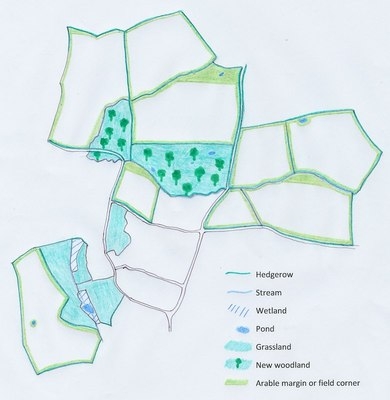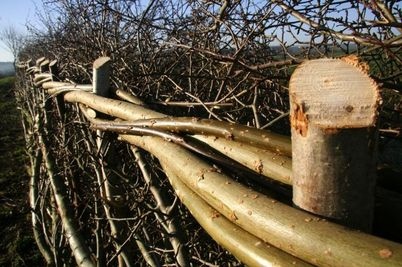ConservationManor Farm has been in a agri-environment scheme since 1997 and during that time we have seen the diversity of farmland birds and mammals increase substantially. Initially only small areas were included in conservation management, however, as we started to see the benefits to wildlife we have dedicated a greater area of land to conservation. 6 meter margins around all the fields along with field corners and areas of pollen and nectar mix now occupy around 8.5 hectares of previously arable land. |
| In spring 2002 a bird survey was completed of the whole farm and we found 47 species of bird. By 2005 the number of species had increased to 60. This increase coincided with us planting 13 hectares of new woodland and increasing field margin widths around all the fields from 2 to 6 meters. The environmental features maps below highlight how things have changed since the year before we started our first agri-environment scheme. | | Manor Farm Environmental Features Maps | | 1996 | | 2011 | 
| |  |
|
|
| Hedgerows
Hedgerows are hugely important features, part of our natural heritage, the landscape and home to a wide range of wildlife. We have planted over 5km of hedge since 1995 which is approximately 30,000 new hedge plants. In addition we have laid nearly 5km of hedgerow to rejuvenate and thicken our hedges making them even more attractive to wildlife. Hedge laying is a traditional management practice that was done on a 15-20 year rotation to make hedges stock proof. Hedge plants are cut three quarters of the way through the stem at the base and then laid at 45 degrees to form a dense barrier. The cut hedge is then held in place with stakes and binders as shown here. Bumblebee Mix
The bumblebee population in UK has declined by 70% in the last 30 years and this is largely due to the loss of floristically diverse hay meadows and grazing pasture. Today’s agri environment schemes have encouraged farmers to sow pollen and nectar mixes on arable land to provide essential habitat for bumblebees. We have a number of field margins and corners dedicated to bumblebees but of course lots of other insects love the nectar rich habitat aswell. Visit Operation Bumblebee for more information.
New Woodland
The new woodland at Manor Farm was planted for three reasons. Firstly to create a new habitat for wildlife, secondly to enhance the landscape and thirdly to provide wood biomass for wood heating systems on the farm. To find out more about renewable energy at Learning Farm click here. The trees were planted during the winter of 2003/4 and for the following 5 years we kept the ground bare immediately around each tree, using herbicide We have planted mainly native broadleaved species but there are some quick growing non native broadleaves that will provide us with wood within 15 years. These include Italian alder and poplar, we also planted some eucalyptus but they have suffered as a result of the recent cold winters.
Wildlife Ponds
We have 6 ponds of varying sizes on the farm which are a haven for wildlife. Dragonflies and Damselflies hurtle around all summer, frogs, toads and newts are common and many different bird species use the ponds as a water source. Bats are also reliant on our larger ponds using them to feed in the early evening when insect activity is high. The largest pond on the farm is part of a complex of wetlands that originally formed the monastic fish ponds associated with Owston Abbey. This is now a Scheduled Ancient Monument.
| |  | | | | | |  |
|
SAYA SHERIDAN
MANOR FARM
OWSTON
OAKHAM
LEICESTERSHIRE
LE15 8DH
01664 454401
07919 353352
Events |